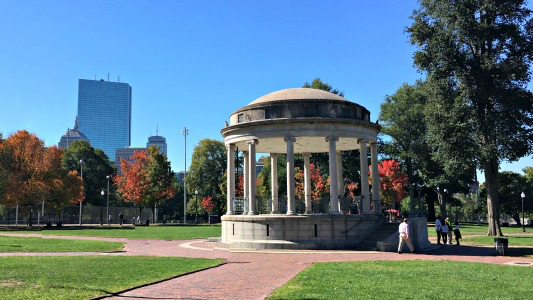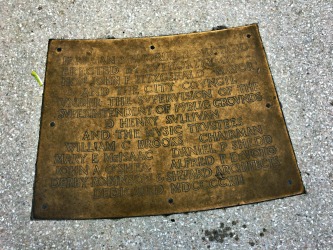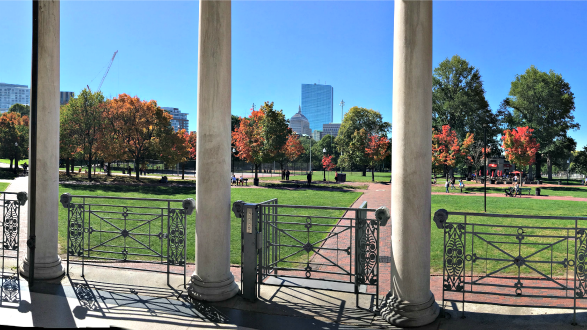Parkman Bandstand

On the eastern side of the Boston Commons is a landmark bandstand. The bandstand is named after George F. Parkman and is officially called the "Parkman Bandstand."
George F. Parkman was the last family member of the Parkman family, a wealthy Bostonian Family. The were consider one of the Boston Brahmin - a class of wealthy, educated, elite members of Boston society in the nineteenth century.
When George Parkman died on September 16, 1908, he gave the city of Boston $5 million for the purpose of taking care of the park. That would be equivalent to $133,064,476.27 in today's value.
This is the second monument that is named after George F. Parkman in the Boston Commons. In front of the visitor center is Parkman Plaza, a circular paved area with three bronze statues representing Industry, Religion, and Learning. The Parkman Plaza was dedicated in 1960.
Interesting Facts
- Parkman Bandstand was open in 1912
- It cost $20,000 to build. ($532,257.91 in today's value)
- Designed by Derby, Robinson and Shepard.
- The Bandstand is modeled after Versailles' Temple d'Amour
- Cow Pond once occupied the site.
- The pond was filled in 1838 when the city of Boston pass an ordinance to ban cattle-grazing on the Commons.
- The Bandstand and pavement around it is about 300 square feet.
- The City of Boston welcome "first night" 1930 with a concert at the Parkman Bandstand
- Charles Lindberg delivered his message from the Parkman Bandstand on July 23, 1927
- Parkman House, 33 Beacon St, Boston, MA, is the Boston's Mayor Official Reception Hall
- The bandstand also gives the Boston Common its most useful platform for public speaking
- It was last restored in 1996 by McKinley Kalsow & Associates
- Handicap ramp was added during the 1996 restoration.
- George F. Parkman is the only person to have 2 monuments named after him in the Boston Commons.
Sign on the Floor
When you walk up the stairs of the Bandstand there is a plaque on the floor that was placed during the 1912 dedication ceremony. The text is all uppercase using an old style too look "clean and classy." This is the old-world style text:
 PARKMAN MEMORIAL BANDSTAND
PARKMAN MEMORIAL BANDSTANDERECTED BY AVTHORITY OF
HON JOHN F FITZGERALD MAYOR
AND THE CITY COVNCIL
VNDER THE SVPERVISION OF THE
SVPERINTENDENT OF PVBLIC GROVNDS
D HENRY SVLLIVAN
AND THE MVSIC TRVSTEES
WILLIAM C BROOKS CHAIRMAN
MARY E MCISAAC DANIEL P SHEDD
JOHN A O'SHEA ALFRED P DEVOTO
BERBY ROBINSON & SHEPARD ARCHITECTS
DEVICATED MDCCCCXII
Notable Yearly Events
- On October 23, 2007 it was the location of the Barack Obama and Deval Patrick Rally on Tuesday.
- Johnson and Weld held a rally on August 22, 2016.
- Shakespeare in the Park happens in the Summer
- The yearly "Castle Hill Concours d'Elegance" car show is held every September around Bandstand
Family Story
There is an interesting side story about George Parkman family.
In 1849, George Parkman father, Dr. George Parkman, was murdered at Harvard Medical School in one of the most famous murder cases in Harvard history.
On November 23, 1849, Dr. George Parkman, a successful surgeon, stopped by Harvard Medical School to collect some money from John White Webster, a Harvard professor. Mr. Webster had some problems with paying off the debt and ended up murdering Mr. Parkman. Mr. Webster placed his parts inside a brick wall. A week later the body was discovered by Ephrain Littlefield, a janitor at Harvard Medical School.
The crime and trial of Mr. Webster was an international sensation. Tickets were sold to those that wanted to sit in the courtroom, and six thousand tickets were sold. The trial lasted for 12-days and John White Webster was convicted of Parkman's murder on March 30, 1850 (127 days after the murder).
He was executed on August 30, 1850. That's 280 days after the murder, and 153 days after being convicted.
There are some historians that believe that John White Webster may not have been guilty of murder and that the murder might have been accomplished by Webster's accuser.
Fall Foliage
The Parkman Bandstand is a great place to take pictures of the Boston Foliage:

